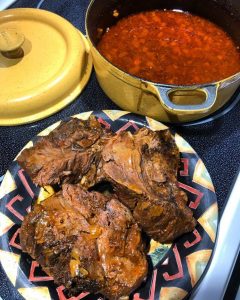
When I posted a photo of a cross-cut moose shank, someone commented that it looked about as thick as the neck of a whitetail deer. I suppose that depends on where you hunt, but the shanks of a moose surely supply a few decent meals; delicious meals, if done right. Now you can grind them all into burger, but frankly, I think that’s a sin. Read on to learn my simple recipe for melt-in-your-mouth moose shank meat.
Granted, it’s not too difficult to turn the shanks into an inedible, tasteless chunk of hard rubber. The three key ingredients to beautiful, succulent shanks are: moisture, low heat, and time. All the rest is optional, though I do not recommend skipping on some spices.
It doesn’t matter if you cut the shanks bone-in, or if you strip them and tie them into a roast, or you just process them as they come off the bone. Take the meat, dry it with some paper towel and rub it generously with course salt, pepper (black, cayenne, or chili flakes), garlic powder, smoked paprika powder, and regular paprika powder. Brown the meat (like really nicely browned) in oil in a Dutch oven, or another pot that can go into the oven.
Take out the meat, put it aside and brown a couple of onions, and a handful of chopped garlic cloves in the residual oil (or add more if necessary). Add a generous amount of chili powder and brown that along with the onions. Throw in a small can of tomato paste and brown that for a bit too.
Return the meat to the pot, throw in two (or more) bouillon cubes, and add (Key Ingredient #1) hot water (recently boiled) to the pot to cover about 80% of the meat (or more). Put the lid on and put the pot into the oven that was preheated to (Key Ingredient #2) 280 oF. Keep it in there for 7 hours (Key Ingredient #3). Have a peak after 4 hours or so. The shank muscles tend to contract and bunch up and rise above the liquid. Turn the meat over so the other side sits in liquid for the remainder of the time.
When done, the meat should be fork tender like this:
All the nasty tissue has dissolved or turned gelatinous, and the meat is soft, and flavourful.
Now, if you have time, and are so inclined, you could take the meat out, and cool the liquid in the pot. The fats will solidify so you can scoop them off. Or you can just skip that step. Depending on how thick you want your gravy and the amount of liquid you used, you may want to take a heaping table spoon of cornstarch, mix it with some of the liquid and stir it through the gravy. A few minutes of simmering will thicken it.
Serve with whatever you feel like.
Cheers!
FD